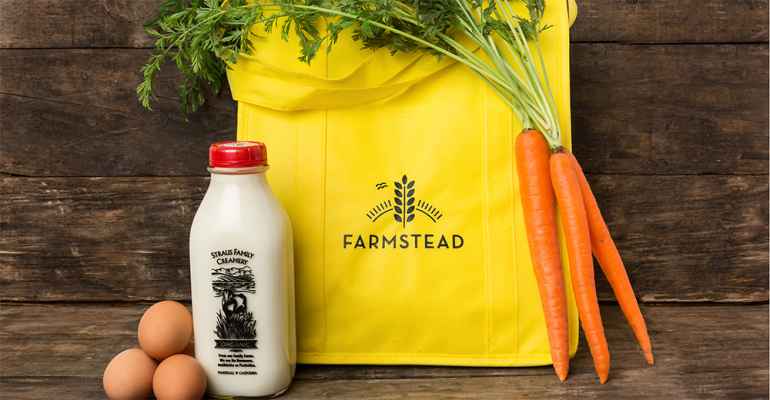E-grocer Farmstead is taking its technology platform on the road to help national and regional retailers bring online grocery delivery in-house.
Farmstead said yesterday that its Grocery OS grocery delivery software is now available to grocers nationwide. The solution is designed to boost the delivery capacity and profitability of retailer-controlled pickup/delivery fulfillment operations — whether from a supermarket, “dark store” space or delivery-only warehouse — and enable self-management of marketing, order picking, packing and delivery, according to the Burlingame, Calif.-based company.
In announcing the move, Farmstead took aim at e-tail giant Amazon, explaining that the release of Grocery OS to other retailers could “help those grocers combat Amazon’s national threat.” Farmstead also said Grocery OS’ release comes “on the heels” of this month’s opening of an online-only “dark store” in the New York City borough of Brooklyn by Amazon subsidiary Whole Foods Market.
So far, a “top three” U.S. grocery has deployed Grocery OS to help expand delivery capacity in regional markets on the East Coast, Farmstead reported. However, a spokeswoman for Farmstead said the company isn’t yet able to publicly identify that Grocery OS user.

“As COVID-19 drives skyrocketing online grocery adoption, many grocers are realizing that a new way forward is required immediately,” Pradeep Elankumaran (left), co-founder and CEO of Farmstead, said in a statement. “Existing third-party delivery options increase customers’ costs to levels approximately 20% higher than what the typical US household can support each week and increase grocers’ fulfillment costs to unsustainable levels. New robotics options increase grocers’ expenses dramatically without actually driving the additional growth required to get to profitability.”
Farmstead said its systems have been built from the ground up to hone the economics of perishable-focused delivery and have powered the delivery expansion of the company’s e-grocery delivery operations in the San Francisco Bay Area over the last four years. Similarly, Grocery OS is aimed at helping grocery retailers bring high-capacity daily deliveries to customers’ doorsteps while better controlling online grocery fulfillment costs and passing the savings to their shoppers, the company said.
Using Grocery OS, retailers can provide free delivery and add another 100 to 150 orders daily from each supermarket while offering the same selection and prices as in stores, according to Farmstead. Dark stores can increase capacity to over 1,000 orders per daily, and custom warehouses employing the solution can support up to 10,000 orders a day, based on space and SKU selection.
Farmstead noted that Grocery OS is designed to easily integrate with grocers’ existing operations and workforce. The platform includes local market digital-demand generation that connects to retailers’ current apps, helping them find, attract and retain in-store shoppers, with customer acquisition costs in the low double digits, the company said.
Orders are picked by the retailer’s associates using Farmstead’s software, with pick rates in the hundreds of items per hour. Farmstead said its custom-built technology for picking and packing of online orders in supermarket, dark store and warehouse locations and warehouses cuts costs by half.
Retailers using Grocery OS can dispatch their own drivers to provide last-mile one-hour (five-mile radius) and batched same-day delivery (50-mile radius) for very low or no delivery fees, with no added per-order fees and a delivery cost to the grocer that’s typically less than $10 per order, said Farmstead. The software also can support online grocery pickup and orchestration, with cutoffs as low as 20 minutes before the customer arrives.
Other Grocery OS features include inventory control, competitive pricing intelligence, customer analytics and CPG marketing, and assortment curation to cut food waste from over 35% to sub-5% and drive bigger customer baskets.
Farmstead reported that Grocery OS slashes transaction costs to the grocery retailer by 10 to 15 times compared with existing options. According to Elankumaran, retailers’ recent efforts to recruit their own pick-and-delivery staff and set up operations in dark stores or other facilities are proving inefficient in meeting rising online grocery demand.
“Unfortunately, controlling costs in dark grocery environments requires substantial technology improvements and orchestration that to date have been inaccessible to national grocers,” he stated.
Grocery OS also provides access to strategic expansion support from Farmstead’s business and operations teams for grocer retailers without their own pick/pack or last-mile delivery workforces.
Farmstead already has brought its e-commerce know-how to other grocery operators. Last September, Farmstead partnered with Alex Lee Inc. to open “microhubs” in the Carolinas to fulfill online grocery orders for the food distributor and retailer. The companies said the delivery-centric microhubs can serve online grocery customers within a 50-mile radius and can be built in less than eight weeks for $100,000, enabling them to enter new market areas faster. Alex Lee, which owns grocery wholesaler Merchants Distributors (MDI) and supermarket chain Lowes Foods, serves as the primary supplier for the e-commerce hubs.





